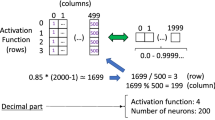Abstract
GMDH, which stands for Group Method Data Handling, is an evolutionary type of neural network. It has received much attention in the supercomputing research community because of its ability to optimize its internal structure for maximum prediction accuracy. GMDH works by evolving itself from a basic network, expanding its number of neurons and hidden layer until no further performance gain can be obtained. Earlier on, the authors proposed a novel strategy that extends existing GMDH neural network techniques. The new strategy, called residual-feedback, retains and reuses past prediction errors as part of the multivariate sample data that provides relevant multivariate inputs to the GMDH neural networks. This is important because the strength of GMDH, like any neural network, is in predicting outcomes from multivariate data, and it is very noise-tolerant. GMDH is a well-known ensemble type of prediction method that is capable of modeling highly non-linear relations. Maximum accuracy is often achieved by using only the minimum amount of network neurons and simplest layered structure. This paper contributes to the technical design of implementing GMDH on GPU memory where all the weight computations run on parallel GPU memory blocks. It is a first step towards developing complex neural network architecture on GPU with the capability of evolving and expanding its structure to minimally sufficient for obtaining the maximum prediction accuracy based on the given input data.


























Similar content being viewed by others
Notes
References
Ivakhnenko AG (1971) Polynomial theory of complex systems. IEEE Trans Syst Man Cybern SMC–1(4):364–378
Yefimenko SM (2012) Optimal Paralleling for Solving Combinatorial Modelling Problems using Graphics Processing Units, The 5th International Workshop on Inductive Modelling IWIM 2012, pp 57–59
Sarka D (2009) The ART (and ARIMA) of forecasting, Technical Presentation, Solid Quality Mentors, http://blogs.solidq.com/dsarka/home.aspx, Last accessed on April 23
Fong S, Nannan Z, Wong RK, Yang X-S (2012) Rare events forecasting using a residual-feedback GMDH neural network. 2012 IEEE 12th international conference on data mining workshops (ICDMW), pp 464–473
Ivakhnenko AG (1970) Heuristic self-organization in problems of engineering cybernetics. Automatica 6:207–219
Ivakhnenko AG, Zholnarskiy AA (1992) Estimating the coefficients of polynomials in parametric GMDH algorithms by the improved instrumental variables method. J Autom Inf Sci 25(3):25–32
Sarychev AP (1984) A multilayer nonlinear harmonic GMDH algorithm for self-organization of predicting models. Sov Autom Control 17(4):90–95
Duffy JJ, Franklin MA (1975) A learning identification algorithm and its application to an environmental system. IEEE Trans Syst Man Cybern SMC–5(2):226–240
Kozubovskiy SF (1986) Determination of the optimal set of lagging arguments for a difference predicting model by correlation analysis. Sov J Autom Inf Sci 19(2):77–79
Karnazes PA, Bonnell RD (1982) Systems identification techniques using the group method of data handling. In: Proceedings of the 6th symposium on identification and system parameter estimation, vol 1, Washington DC. International Federation of Automatic Control, Pergamon, pp 713–718
Kendall M, Gibbons JD (1990) Rank correlation methods. Edward Arnold, London
Loquasto F, Seborg DE (2003) Monitoring model predictive control systems using pattern classification and neural networks. J Ind Eng Chem Res 42:4689–4701
Narasimhana S, Vachhanib P, Rengaswamya R (2008) New nonlinear residual feedback observer for fault diagnosis in nonlinear systems. Automatica 44(9):2222–2229
Lanitis A (2003) Building statistical appearance models using residual information. in Proceedings of 9th Panhellenic Conference in Informatics. Thessaloniki, Nov., pp 547–559
Rossen A (2011) On the predictive content of nonlinear transformations of lagged autoregression residuals and time series observations, HWWI Research Papers, No. 113, Hamburg Institute of International Economics, pp 1–24
Schetinin V (2003) A learning algorithm for evolving cascade neural networks. J Neural Process Lett 17(1):21–31
Varahrami V (2011) Recognition of good prediction of gold price between MLFF and GMDH neural network. J Econ Int Financ 3(4):204–210
LeCun Y, Bottou L, Bengio Y, Haffner P (1998) Gradient-based learning applied to document recognition. Proc IEEE 86(11):2278–2324
Qin Yechena, Langari Rezab, Lianga Gu (2015) A new modeling algorithm based on ANFIS and GMDH. J Intell Fuzzy Syst 29(4):1321–1329
Wang Lipo, Quek Hou Chai, Tee Keng Hoe, Zhou Nina, Wan Chunru (2005) Optimal Size of a Feedforward Neural Network: How Much does it Matter?, Joint International Conference on Autonomic and Autonomous Systems and International Conference on Networking and Services, pp 6–9 Date 23–28 Oct. (2005)
Brito Ricardo, Fong Simon, Cho Kyungeun, Song Wei, Wong Raymond, Mohammed Sabah, Fiaidhi Jinan (2016) GPU-enabled back-propagation artificial neural network for digit recognition in parallel, The Journal of Supercomputing, Springer, February 2016, pp 1–19
Acknowledgments
The authors are thankful for the financial support from the research grant “Rare Event Forecasting and Monitoring in Spatial Wireless Sensor Network Data,” Grant No. MYRG2014-00065-FST, and Grant No. FDCT/126/2014/A3, offered by the University of Macau, and Macau SAR Government.
Author information
Authors and Affiliations
Corresponding author
Rights and permissions
About this article
Cite this article
Brito, R., Fong, S., Cho, K. et al. Towards implementation of residual-feedback GMDH neural network on parallel GPU memory guided by a regression curve. J Supercomput 72, 3993–4020 (2016). https://doi.org/10.1007/s11227-016-1740-9
Published:
Issue Date:
DOI: https://doi.org/10.1007/s11227-016-1740-9




